20 Herbs You Can Make Medicine From

Herbs have more uses than adding flavor to your dinner. Herbs have medicinal properties that people have been tapping into for centuries. Before the time of modern medicine, you would use herbs to cure your ailments and sicknesses. People knew how to make medicine out of the herbs they grew and foraged.
Thankfully, we do have modern medicine available to us. Herbalism is still a skill that everyone, especially survivalists and preppers, should learn. During and after an SHTF scenario, you can use the plants you grow or forage to solve your colds and coughs.
Some herbs are more popular than others. There are plants you see and use every day that has medicinal properties! Those herbs you put in your soup last night more than likely have properties you would never suspect. Let’s take a look at 20 herbs that you should know about and know how to use.

#1. Calendula
Calendula is one of the most familiar herbs and one of the first that budding herbalist starts to use. The pleasant, golden flowers make them a lovely addition to your outside flower beds. These golden orange petals are edible, but the entire flower has medicinal properties.
Calendula is known for its ability to heal skin conditions, which is why you might find lotions and soaps in the store containing calendula. In fact, you can make all sorts of things with calendula, like soap, lip balm and lotion bars. Aside from medicinal uses, you can add the flower petals to cakes, soups, and salads.
It is important to note that calendula can stimulate menstruation. Therefore, pregnant women should not consume calendula internally unless approved by their healthcare provider!
What Calendula Can Heal
- Wounds
- Rashes
- Burns
- Dry skin
- Anti-fungal
- Anti-bacterial
- Emmenagogue – stimulates the menses
- Eases digestive inflammation such as GERD and ulcers
Ways to Use Calendula
- Topical ointments and salves. If you want to try your hand at making a calendula salve, try this recipe.
- Diaper rash ointments
- Calendula tea
To make calendula tea, you can use fresh or dried flowers. For dried flowers, put 1 to 2 TBSP dried flowers in one cup of hot water. Allow steeping for 15 to 20 minutes. If you use fresh flowers, simply pour the hot water over the fresh flowers and allow to infuse until cooled.
- Tinctures
- Infused Oil
Calendula tea is one of my favorite ways to use this herb. You can gargle it for a sore throat or use a mouth rinse. It is also great for homemade baby wipes or to use a disinfecting skin spray!

#2. Motherwort
There is a good chance you’ve never heard of motherwort, but it happens to be one of the easiest herbs to grow. If you have a black thumb, don’t be afraid of motherwort. Motherwort offers versatility because it can be used for so many ailments!
Motherwort is best known for its stress and anxiety relieving properties. Women who are entering menopause can find relief through motherwort. It can ease those pesky hot flashes and hormonal irritability. It can even be used during childbirth to strengthen contractions. It is truly a handy herb to grow!
What Motherwort Can Cure
- Stress and anxiety
- Lessen menstrual cramps
- Muscle sprains and aches
- Headaches
- Nervous heart conditions
- Postpartum healing
- Hypothyroidism
Ways to Use Motherwort
- Motherwort Tea
You can use motherwort as a tea, but it does have a bitter flavor. To make motherwort tea, use 1 to 2 TSP dried leaves in an 8oz mug. Pour boiling water over and let steep for 10 minutes.
- Tincture
To make a tincture, you use the leaves, stems, and flowers. Chop up enough fresh motherwort to fill a quart jar. Pour alcohol, such as vodka, over the top. Make sure to leave ¼ inch headroom. You should use alcohol that is consumable, so don’t use rubbing alcohol! Apple cider vinegar is another option.
Put this jar in a cool, dark place. Gently shake daily. You might have to add more alcohol if the plant soaks up the liquid. Strain the liquids after six weeks. Discard all of the plant matter. You can add drops of the tincture to juice or water, but don’t take more than three times daily!
Put this jar in a cool, dark place. Gently shake daily. You might have to add more alcohol if the plant soaks up the liquid. Strain the liquids after six weeks. Discard all of the plant matter. You can add drops of the tincture to juice or water, but don’t take more than three times daily!
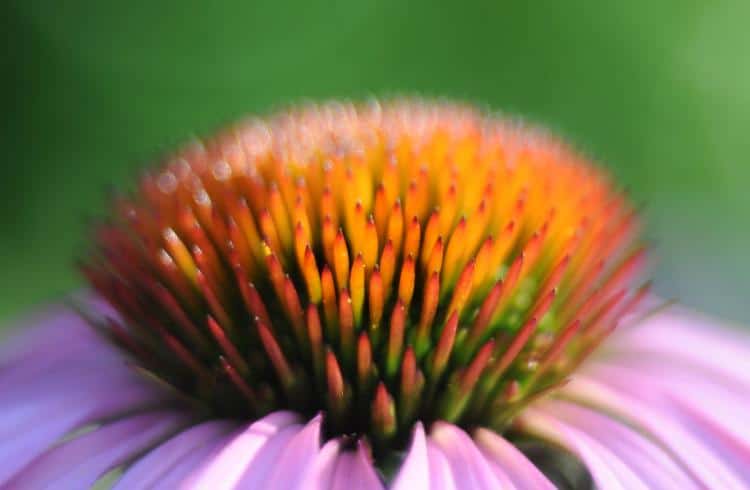
#3. Echinacea
Echinacea is a gateway herb to the world of herbalism. It can be found as a supplement or tea in most stores, allowing those who are unsure about herbs to give it a try. Gardeners love to grow echinacea because it creates a beautiful, purple coneflower that is perfect for ornamental flower beds. It attracts butterflies and bees, making it a great addition. Best of all, it can withstand most neglect and still grow vivaciously.
All parts of echinacea, such as the roots, seeds and fresh flowers, contain medicinal properties. It works as active chemicals in your body, fighting fungus, kicking the flu and reducing inflammation.
What Echinacea Can Cure
- Common Cold
- Sore throats
- Bronchitis
- Stimulate growth of blood cells
- Improves immune system
- Relieves stiff joints
How to Use Echinacea
- Capsules – purchase at the store
- Echinacea tea
You can consume up to three cups of echinacea tea daily if you want to boost your immune system. All you need is a ¼ cup of echinacea flower petals, leaves and roots. Boil a cup of water and pour it over top of the echinacea parts. Allow to steep for five minutes, strain and drink!
- Tinctures

#4. Lavender
Almost everyone knows that lavender has healing benefits, but many don’t realize it can do more than help you drift off to sleep. Lavender is best known for its calming and relaxing properties, being used to solve insomnia, anxiety, depression, stress and more.
Most people don’t know that lavender also has antibacterial, antiviral, and anti-inflammatory properties!
Lavender tends to be one of the first herbs that people start to use. Originating in southern Europe, lavender can trace its herbal roots back into ancient and medieval cultures. People used it for pain relieving and sedative properties! Studies show us that lavender can help to improve your memory, mood, and overall cognitive function.
What Lavender Can Cure
- Relieve Pain
- Treat skin disorders like acne, eczema, and psoriasis
- Keep Hair Healthy
- Improve Digestion
- Relieve respiratory disorders
- Stimulate urine
- Improve blood circulation
- Heals wounds, cuts and burns
- Soothes Insect Bites
- Itchy Skin
How to Use Lavender
- Ointments and Salves
- Massage lavender oil onto sore muscles and backaches
- Lavender Tea
One of the easiest ways to use lavender is with a lavender tea! You use 1 to 2 TSPs of the dried flower or herb in 8 ounces of boiling water. You can drink lavender tea up to three times daily. If you have dandruff, you can use a strong batch of lavender tea as a scalp rinse.
- Tincture
- Small Satchels
You can sew small satchels and fill them with dried lavender. Put these satchels in your pillow or dryer to help sleep!
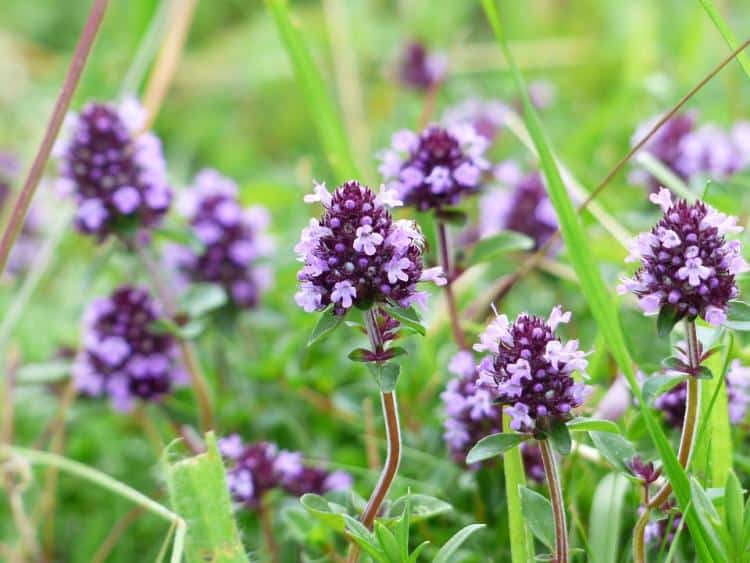
#5. Thyme
If you spend any time in the kitchen, you are somewhat familiar with thyme. Thyme is a lovely, fragrant herb that is rich in antioxidants and flavonoids that offer dozens of health benefits. You might be surprised to learn this one herb contains vitamin C, vitamin A, iron, copper, dietary fiber, and manganese!
Thyme has been used as far back as Ancient Egypt! The Egyptians used thyme for embalming and to heal many medical conditions. It offers anti-fungal, anti-viral, anti-septic and antiseptic properties. You can use its flowers, leaves, and oil. While you might not be embalming anyone anytime soon, there are plenty of other ways you can use thyme.
What Thyme Can Cure
- Gout
- Arthritis
- Skin Wounds
- Bug bites and stings
- Sores
- Menstrual and menopause issues
- Nausea
- Fatigue
- Respiratory problems
- Athletes foot
- Depression
How to Use Thyme
- Poultice
Make a poultice by crushing up thyme leaves into a paste and applying it to sores and skin inflammation.
- Tincture
- Thyme Tea
For those suffering from gastric issue or bronchitis, thyme tea can solve the problems. Mix one teaspoon of dried thyme leaves in a cup of boiling water. Allow to steep for 10 to 15 minutes. Strain and sip. You can add honey, especially if have respiratory problems!
- Infused Oils – for muscle spasms and skin irritation
- Aromatherapy
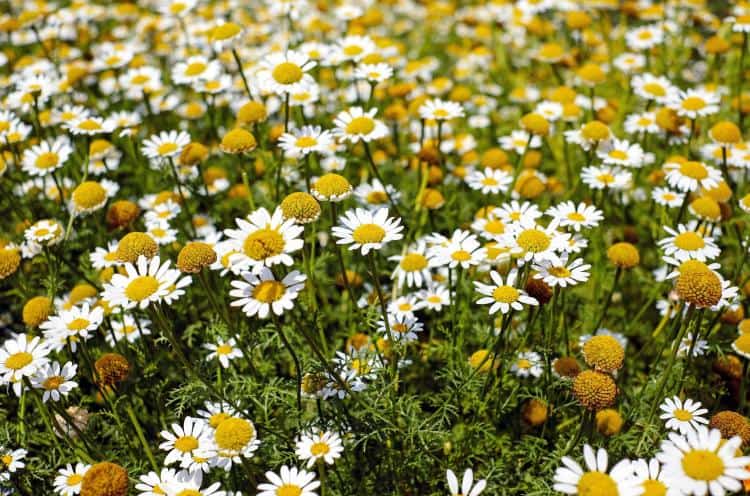
#6. Chamomile
Another well-known herb that contains medicinal benefits is chamomile. Most people know that chamomile can help put you to sleep and ease anxiety, but there are other uses you should know. One of the most noted uses is to help calm upset stomachs!
Herbal remedies use two types of chamomile: Roman chamomile and German chamomile. While there are some slight variations, you can use them both for the same purposes. Mothers, in particular, can find enjoyment in using chamomile. It is safe and gentle enough for children and babies. In fact, chamomile is said to help relieve colic symptoms as well as stomach problems in toddlers!
What Chamomile Can Cure
- Upset stomach
- Reduces morning sickness
- Sleeping issues
- Skin swelling
- Fights bacteria
- Relaxes muscles
- Psoriasis
- Eczema
- Diaper Rashes
- Skin Wounds
- Abscesses
- Gum inflammation
- Menstrual cramps
- Backaches
How to Use Chamomile
- Chamomile Tea
Chamomile tea is most popular way to use it. It can help to improve your appetite, ease anxiety, reduce headaches and calm nausea. To make chamomile tea, boil one cup of water and pour over 1 to 3 TSP dried chamomile. Allow to steep for 15 minutes. Strain and drink. You can drink up to four cups per day. Children over four years old can take a third of the adult dosage.
- Ointments and salves
- Herbal infusion
- Tea bags for puffy or tired eyes
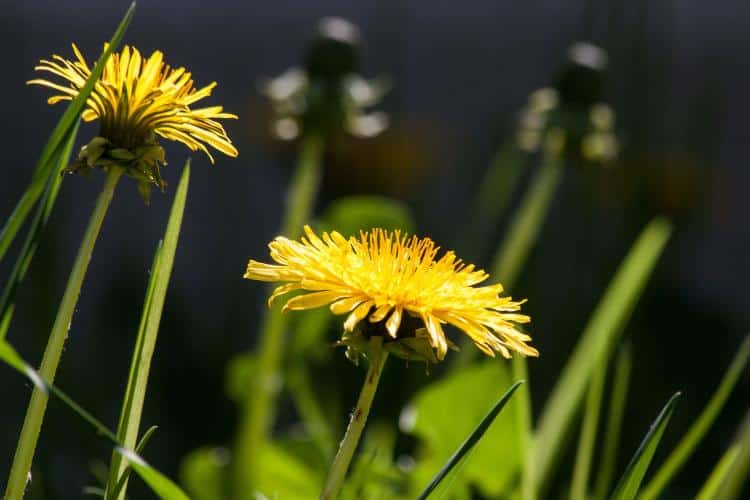
#7. Dandelion
Now you might be surprised. All of those yellow flowers that dot your yard all spring into the summer contains dozens of medicinal benefits. You’ve missed out on a fresh healing source right in your backyard! Dandelion petals are edible and are a source of vitamin C, vitamin B6, calcium, iron, potassium, manganese, and thiamin.
One of the most noted ways to use dandelions is as a liver tonic to help detoxify and improve liver function. Dandelions have also been used for kidney and liver disorders. It can be quite a powerful herb!
While you might think that dandelions are the bane of your yard’s existence, they serve several purposes. You can use the petals in salads! Dandelions make a fantastic, sweet wine if you remove the greens. The blossoms can be used to make jelly. You can fry them while in the bud stage! You can even dry and ground up the roots as a substitute for coffee.
What Dandelions Can Cure
- Treat infections
- Gallbladder issues
- Swelling
- Water retention
- Balances blood sugar
- Relieves ankle swelling
- Improves pancreas function
How to Use Dandelions
- Dandelion Infused Oil
Infused oils can be used to make ointments and salves. You also can use them to make lotion bars! Making dandelion infused oil is simple. First, pick two cups of flowers and allow to dry for 1 to 2 days. Put dried flowers into a jar and fill the rest of the jar with oil. You can use sunflower, almond, or olive oil. Place it in a sunny spot, such as a window, and let steep for two weeks. Strain and discard flower parts. Your oil is ready to use!
- Ointments and salves
- Teas
- Tinctures
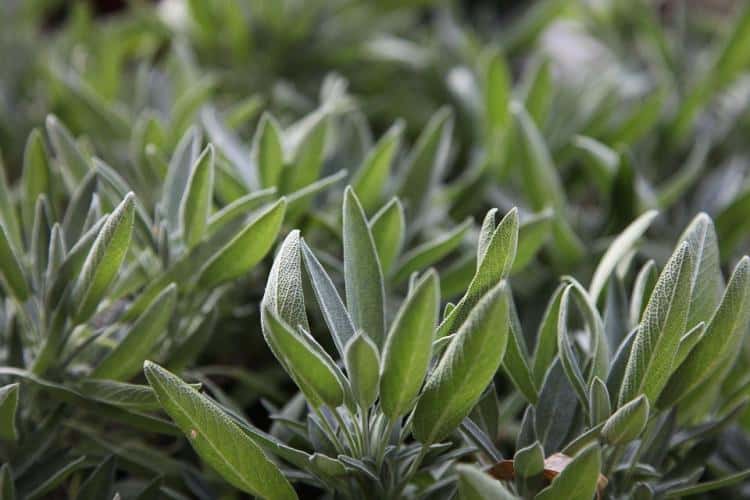
#8. Sage
Sage is a common herb in many medicinal and culinary herbal cabinets. I grew sage for years before realizing that it is a powerful herb for healing purposes. It grows exceptionally well in home gardens. Sage originated in the Mediterranean regions, but now it grows all over the world. Believe it or not, there are over 2,000 species of sage!
When using sage for healing purposes, you can use the stem, flower, and leaves. All of the parts contain properties to cure diseases. It also is rich in nutrients and antioxidants! Sage offers many other medicinal benefits because it can be used as an astringent, stimulant, nervine agent, diuretic, and more!
What Sage Can Cure
What Sage Can Cure
- Anti-septic properties
- Toothaches
- Reduces bad breath
- Balances stomach problems
- Heals skin wounds
- Depression
- Improves memory
- Sore throat
- Ulcers
- Sprains
How to Use Sage
- Sage Tea
Sage tea is easy to make, just like all of the other recipes listed above. You can sip on it, use it as a mouth rinse for ulcers, gargle with a teaspoon of sea salt for a sore throat or soak a cloth in the sage tea as a compress.
- Hot Tea Compress for headaches
- Chew fresh leaves
- Poultice for joint pain
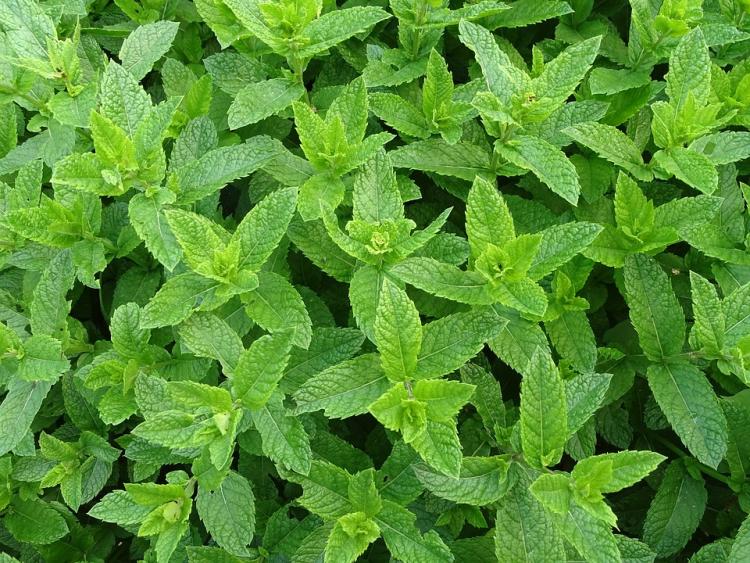
#9. Peppermint
All members of the mint family offer medicinal properties. Peppermint happens to be one of the most popular in the mint family. Peppermint oil is often used as a food flavoring, like in candy canes!
The plant is most commonly thought of for its calming properties. Peppermint also has anti-bacterial and anti-fungal properties. Peppermint is great for aiding digestive issues. It can soothe and calm your uneasy digestive system whether you use it internally or externally. Women could use it for morning sickness! It also helps to get rid of gas, indigestion, heartburn and motion sickness.
What Peppermint Can Cure
- Digestive issues
- Prevent prostate cancer
- Muscle pain
- Sinus infections
- Enhances memory
How to Use Peppermint
- Peppermint Tea
If you want to calm morning sickness or an uneasy stomach, try a cup of warm, peppermint tea! Peppermint tea can also relieve a headache or reduce colic if rubbed externally on an infant’s stomach. All you need to do is take 1 to 2 TSP dried peppermint leaves and steep in one cup of boiling water for 15 minutes. Strain and sip!
- Tincture
- Peppermint essential oil
- Salves for sore joints
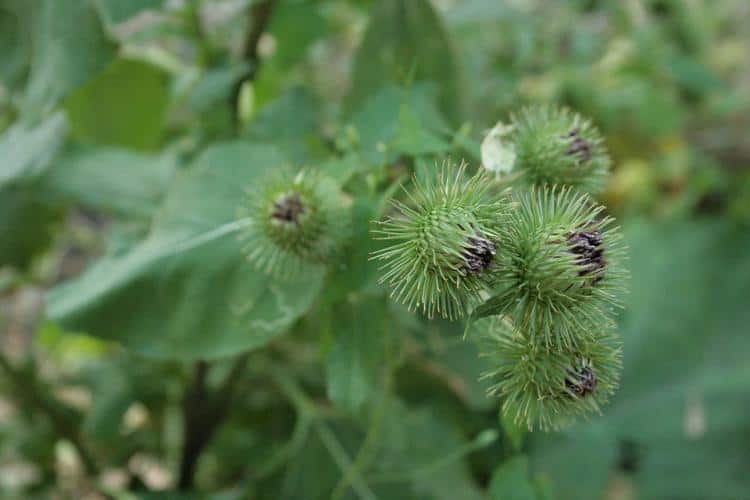
#10. Burdock
Burdock isn’t very common in most American gardens, but it should be. Burdock has been used for centuries as a herbal remedy. The roots can be used as a blood purifier. Herbalists can use the leaves as a poultice to draw out infections. Burdock has several medicinal properties such as being a diuretic, depilatory, and helps to heal skin issues.
However, those who decide to use burdock must be cautious. The seeds are very powerful and create strong medicine. You shouldn’t use burdock seeds unless you are a more experienced herbalist.
What Burdock Can Cure
- Gout
- Arthritis
- Glandular swelling
- Canker Sores
- Sciatica
- Burns
- Skin Wounds
- Hemorrhoids
How to Use Burdock
- Salve
- Burdock Tea
To make burdock tea, you need 1 TSP dried herb or 3 TSP fresh herb in one cup of boiling water. Allow to steep for 10 minutes. Avoid steeping too long. You can add more herbs, but don’t change the steeping time because the tea will become rather bitter. Cream can improve the taste.
- Decoction
Making a decoction is easy. You can use the root or seeds. Take an ounce of the root and simmer in a pint and half of water for 30 minutes. Strain carefully afterward and drink. Make sure you are simmering and never hard boiling!
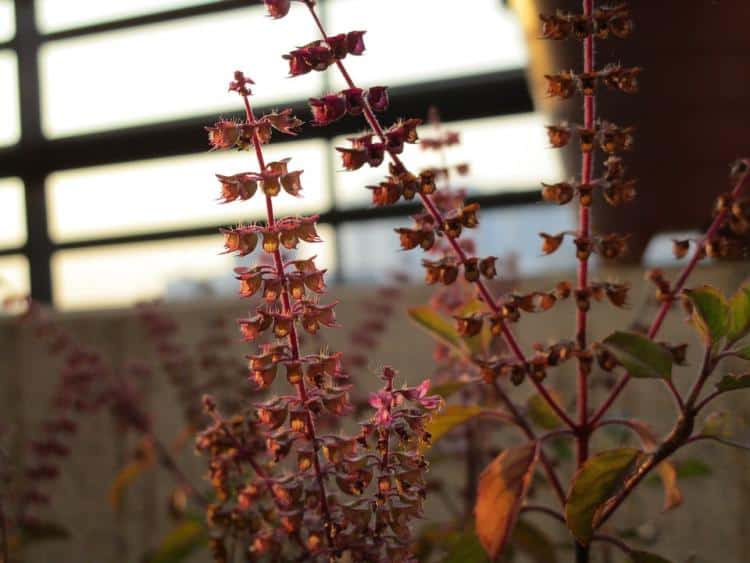
#11. Holy Basil
Holy basil is a relative to the Basil grown in other areas of the world. It is growing in popularity, known for creating a delicious, herbal tea. People love the aromatic and antimicrobial properties. The leaves and flowers are perfect for teas to fight colds and coughs, along with other ailments. At the same time, holy basil offers an uplifting effect that can help you focus and find mental clarity.
People believe that Holy Basil is an adaptogen. That means it will adapt to serve the body where it is needed the most. Adaptogens are said to have stress relieving properties as well. Holy basil also has antibacterial and antifungal properties.
As you might have guessed, holy basil is a cousin of the basil you might use in your tomato sauce. You can swap out the fresh leaves of basil with holy basil to whatever dish you want. Holy basil is more pungent and strong!
What Holy Basil Can Cure
- Colds
- Coughs
- Asthma
- Bronchitis
- Sinus Infections
- Headaches
- Arthritis
- Stress and anxiety
- Fever-reducing
- Sore throats
How to Use Holy Basil
- Holy Basil Tea
The easiest way to reap the benefits of holy basil is in a tea. Cover 2 TSP of leaves with 8 ounces of boiling water. Cover and allow to steep for 5 minutes. Strain and drink!
- Tinctures
Another way to take advantage of the benefits is by placing one part fresh holy basil and two parts high proof alcohol into a jar. Allow this to set in a cool, dark place for five weeks. Strain and your tincture is ready.
- Aromatherapy
- Sprays
- Leaf paste
#12. Spilanthes – Toothache Plant
Never heard of spilanthes? That is okay! Many people haven’t, but it should be more popular than it is. Spilanthes creates a golden, globe-shaped flower with a lovely, red center. You might think of them as eyeballs in the prettiest sense.
Spilanthes has quite a unique flavor, and it is a very strong sialagogue, which means saliva promoter. If you decide to take a little nibble of the flower, you are likely to drool everywhere. The plant creates a tingly, numbing sensation that gives it the name toothache plant. People use it in their tooth and gum remedies. Aside from being able to give you the numbing sensation, spilanthes also offers anti-microbial properties.
All of the aboveground parts of the part are medicinal. You can chew most parts fresh, so long as you do so with moderation. Some people love to create formulas with echinacea to help stimulate the immune system. There are other uses for the toothache plant as well!
What Spilanthes Can Cure
- Fights common colds and flu
- Toothaches
- Dry mouth
- Sore throats
- Immune system boosting
- Thrush
- Cold sores
- Ringworm
How to Use Spilanthes
- Chewed fresh
- Tincture
To make a tincture from fresh spilanthes, put the chopped leaves, flowers and steps into a glass jar. Add 80 proof vodka (or higher) into the jar, making sure to cover the plant matter. Store in a cool, dark place for four to six weeks. Strain and store.
To use the tincture, you can mix with honey or add a dropper to a drink for an upset stomach. You can use as mouthwash by adding drops to water.
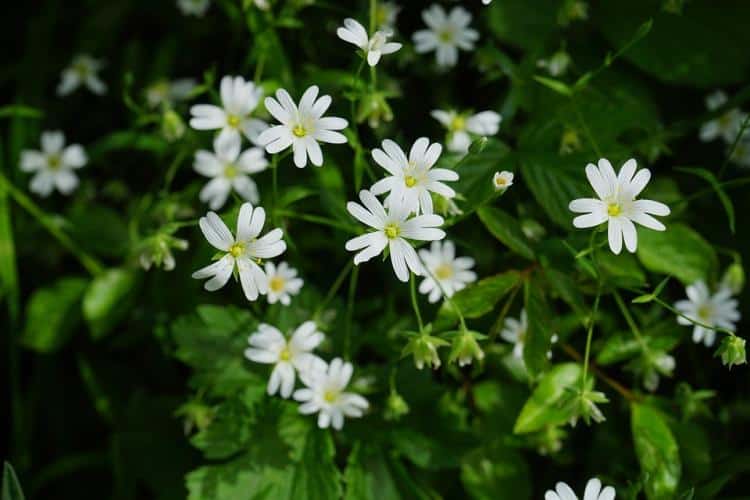
#13. Chickweed
Chickweed is a medicinal and edible wild herb that might be growing on your property. This little plant is nutritious, containing plenty of vitamins and minerals, such as calcium, beta-carotene, magnesium, potassium, and zinc.
Aside from using it in home remedies, you can also add chickweed to salads. You might think it tastes similar to spinach! You can use the entire plant in your home remedies. Chickweed has astringent, diuretic, expectorant, laxative, and demulcent properties. That is impressive for a plant most consider a weed.
What Chickweed Can Cure
- Postpartum depurative
- Emmenagogue
- Constipation
- Coughs
- Hoarseness
- Antihistamine
- Rheumatic pains
- Skin Wounds
- Ulcers
- Roseola
How to Use Chickweed
- Decoction
- Salves
- Infusions
- Medicinal poultice
- Medicinal Tea
To make chickweed tea, combine 1 TBSP dried chickweed OR 2 TBSP fresh chickweed into 1 cup boiling water. Steep for 10 minutes. Sip on ½ cup portions, two to four times daily during a cold or flu.
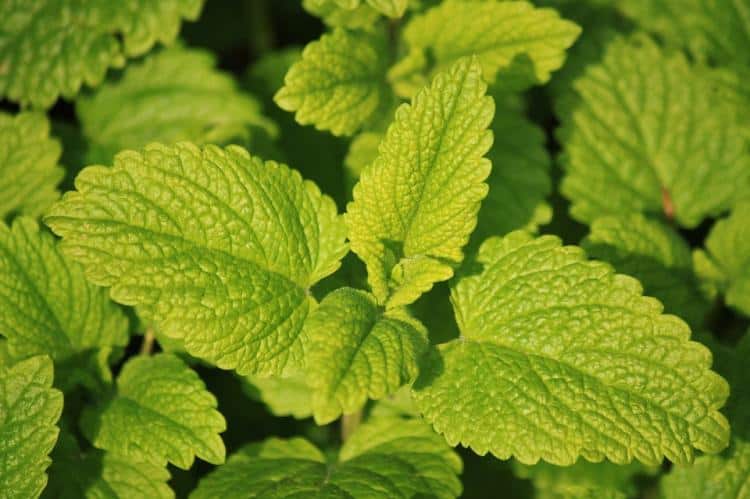
#14. Lemon Balm
Lemon balm is in the mint family, just like the above-mentioned peppermint. It has a lovely, citrusy-mint scent that can uplift you immediately. Lemon balm is an easy to grow herb that will attract bees to your garden. Aside from having lovely aromatic benefits, lemon balm is known for its anti-viral and relaxing properties.
For centuries, lemon balm has been used as a way to treat colic and upset stomach. Infants and adults can reap the benefits. You can chew on fresh leaves if your breath smells bad. Try applying a crushed leaf to a bug bite to ease the annoying itchiness.
Just be aware that lemon balm will overtake your garden. I made the mistake of planting it right in the middle of my flower bed. I had to trim and harvest constantly. It wanted to spread everywhere. If you don’t want to be harvesting and creating herbal remedies constantly, I suggest you grow lemon balm in a container.
What Can Lemon Balm Cure
- Animal Bites
- Bug Bites
- Sores
- Fevers
- Colds and coughs
- Insomnia
- Upset stomach
- Headaches
- Depression
How to Use Lemon Balm
- Sleepy Time Herbal Syrup
If you are having trouble with insomnia, try an herbal syrup. Put ¾ cup lemon balm into a pot and add just enough water to cover the leaves. Simmer until half reduces liquid. Strain. Combine ½ of the concentrated tea to ¼ cup honey. You want the ratio to be two parts lemon balm infusion and one part honey. Take a dose at night before bed!
- Herbal Tea
- Bath satchel filled with dried herbs
- Lip balm for cold sores
- Tincture
Making a lemon balm tincture is the same as any of the other listed tinctures. It is great for soothing an upset stomach or for those times when you feel a cold or flu coming.
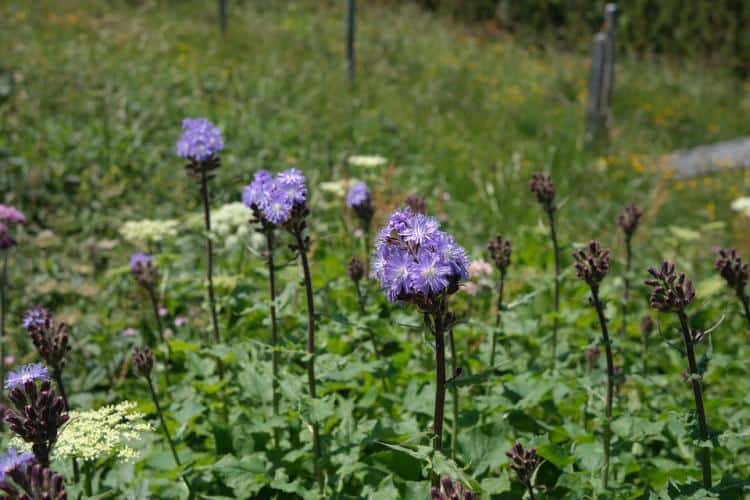
#15. Milk Thistle
Milk thistle originates in Mediterranean climates, but it has adapted to climates in North America. Milk thistle grows with a tall stem and a flower filled with purple petals. Herbalist commonly relies on milk thistle for the treatment of liver and gallbladder issues, such as cirrhosis and hepatitis. It might be able to help protect your liver from the damage of alcoholism.
What Milk Thistle Can Cure
- Depression
- Hangovers
- Aid digestion
- Stimulates mother’s milk
- Anti-inflammatory
- Inflamed skin conditions
How to Use Milk Thistle
- Tincture
Believe it or not, milk thistle doesn’t extract well into water, so most herbalists don’t recommend using milk thistle as a tea. You simply need to allow dried milk thistle to steep in alcohol for several weeks. You can add this to drinks.
- Dried Seeds – add to different dishes
- Capsules

#16. Witch Hazel
Chances are you’ve heard of witch hazel, but you probably didn’t know you can grow it in your backyard. It is a versatile and useful shrub that can grow in most areas, whether the area is moist or dry. The shrub grows oval, green leaves with flowers. The petals can be dark yellow, orange or red!
Witch hazel is a common ingredient in many astringents and skincare products. If you’ve ever had a dreadful hemorrhoid, you know that witch hazel is extremely useful in bringing relief. There are plenty of other ways to use witch hazel!
What Witch Hazel Can Cure
- Varicose veins
- Hemorrhoids
- Inflammation
- Skin Wounds
- Bruises
- Diarrhea
- Colitis
- Dysentery
- Poison Ivy or poison oak
How to Use Witch Hazel
- Diaper rash cream
- Salves for hemorrhoids
- Healing spray for postpartum
- Witch Hazel Tonic
If you want to make some of the above items, you need to make a tonic or tincture to reap the benefits. You need a ½ pound of witch hazel bark. Put the bark to a pot and cover one to two inches with water. Bring to a boil and simmer for 20 minutes. Remove and strain. Then, add equal parts vodka. You can also leave out the alcohol if you are worried about using it on your child! Store in a cool place.

#17. Aloe Vera
Everyone has heard of aloe vera because nearly everyone has had a painful sunburn requiring its use. An aloe vera plant grows best near water in sandy or rocky terrain. It also is a great indoor plant! The leaves are thick, slender and stiff, growing orange flower spikes.
The healing portion of aloe vera is found inside of the leaves. The gel is in the leaves, and it is known for speeding up the healing process of many skin conditions. At the base of the leaves, a sap is found that can stimulate the digestive system.
What Aloe Vera Can Cure
- Burns
- Skin Wounds
- Digestive Stimulant
- Laxative
- Heartburn
- Bug Bites
How to Use Aloe Vera
- Break off a piece of plant and apply sap directly to your sunburn or bug bite
- Mouthwash
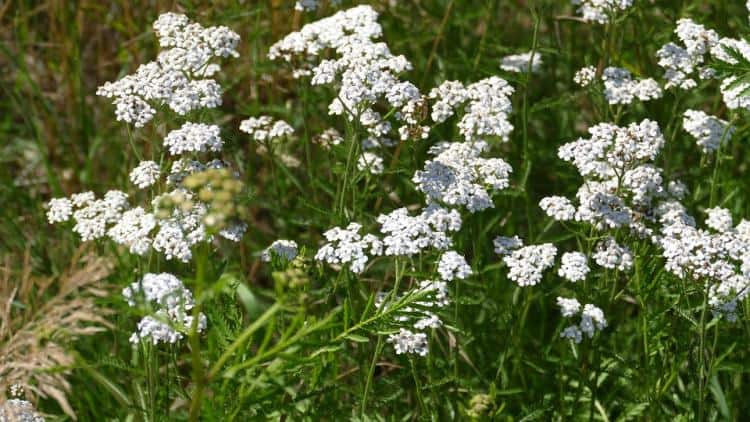
#18. Yarrow
For those who are preparing for a survival scenario, yarrow could be one of the most important herbs to know how to use. In the garden, yarrow is lovely and easy to grow. Despite the ease of growth and beauty, yarrow can be used to stop bleeding, an essential property for those in a survival scenario. It is said that Achilles, from the legend, used yarrow to stop bleeding on the battlefield.
Yarrow works best to stop bleeding when it is dried and powdered, allowing you to pack it into the open wound. However, fresh yellow can help staunch bleeding as well. The leaves and flowers have other medicinal purposes.
What Yarrow Can Cure
- Stops bleeding
- Reduces fevers
- Eases menstrual pain
- Treats the common cold and flu
- Reduces anxiety
- Balance menstrual cycle
- Relieve cramps
How to Use Yarrow
- Herbal Infusion
- Yarrow Tea
To make a yarrow tea, steep 1 TBSP fresh leaves or 1 TSP dried leaves in one cup boiling water. Allow to set for 5 minutes, strain and sweeten with honey!
- Add to salads for vitamins and minerals
- Herbal Facial Steam
- Bath satchels
- Poultice with fresh leaves for bruised areas
- Tincture
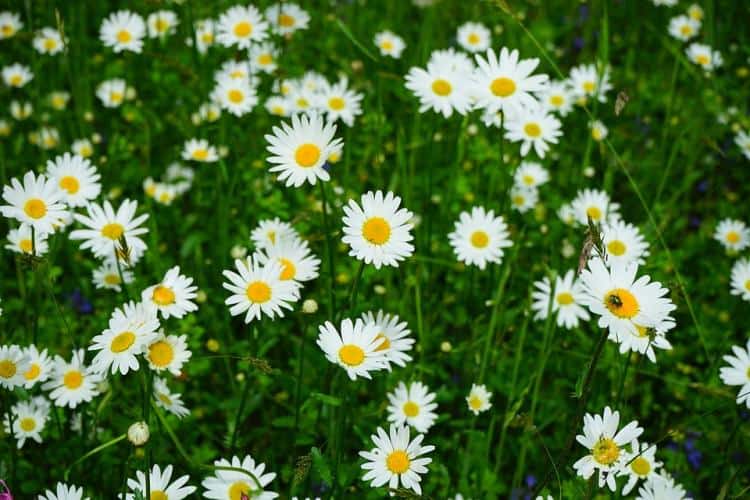
#19. Feverfew
Feverfew often grows like a weed, but some gardeners purposefully grow feverfew in their flower beds. As you can tell by the name, feverfew is helpful to reduce and lower fevers. Some people have great success at using feverfew to reduce migraines when consumed on a daily basis. That is because fever contains vasodilator and anti-inflammation properties.
You should add feverfew to your garden. Not only does it have fantastic herbal benefits, but it also is a perennial that blossoms with hundreds of small, white, daisy-like flowers. It is easy to grow and maintain, perfect for containers. Feverfew is frost hardy and stays evergreen throughout the winter. Are you convinced to add it to your garden yet?
What Feverfew Can Cure
- Lowers fevers
- Reduces migraines
- Treats arthritis
- Sore muscles
- Stress reduction
- Insomnia
How to Use Feverfew
- Chew on fresh leaves to reduce migraines
- Herbal Tea
- Herbal Salve
- Tincture
Chop up fresh feverfew into small pieces and add to a glass jar. Cover with alcohol plus another inch above the plant matter. Shake well and keep an eye on the alcohol level. It can decrease the plant absorbs the alcohol. Shake every few days. Allow to set for the next six weeks. Strain and your tincture are ready! You can take up to ½ TSP per day.

#20. Bergamot
Bergamot, often referred to as bee balm, is a famous herb that is also a pollinator. It is most commonly used in culinary dishes as a flavoring for fish and meat dishes. However, bergamot also has medicinal purposes, typically found in the leaves. The flowers are edible, adding great flavor to your dishes.
There are plenty of ways you can use bee balm. The dried leaves and flowers are great for steam inhalation to break up mucus. Bergamot is most noted for its fragrance, which is why many prefer to use it in the form of an herbal tea.
You can use the leaves, flowers, and stems in your herbal remedies. All of these parts have antiseptic, carminative, diaphoretic, stimulant and diuretic properties.
What Bergamot Can Cure
- Stimulant
- Relieves flatulence
- Reduces fevers
- Headaches
- Common colds
- Sore throats
- Minor skin infections
- Break up mucus
- Menstrual pain
- Insomnia
How to Use Bergamot
- Medicinal Teas
To make bergamot tea, add 1 TSP dried bergamot to one cup boiling water. Allow to steep for 10 minutes. Sweeten with honey as you so desire. Drink it at bedtime to help put you to sleep!
- Salves
- Steam inhalation
If you have a cold or increased mucus, try steam inhalation! All you need to do is add 1 to 2 TSP of dried bergamot to a pot of boiling water. Use a towel to create a tent over your head. Breathe in the bergamot steam to help break up the mucus.
These are just 20 of the medicinal herbs you might want to try to use to make medicine. As you can tell, many of the herbs overlap and share similar properties and uses. Once you learn how to create one tea or tincture, it is easy to start making them with other herbs. Give it a shot!



No comments:
Post a Comment